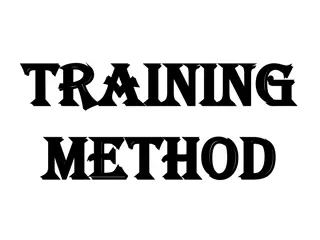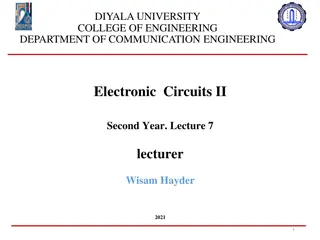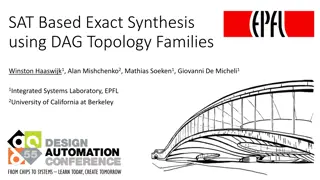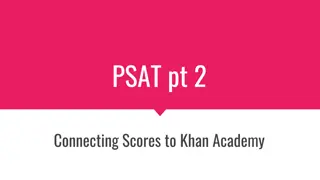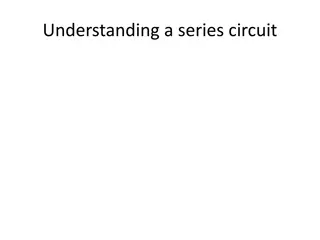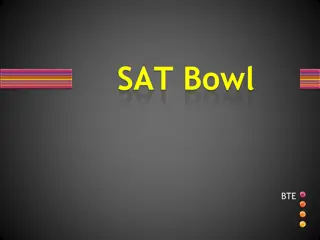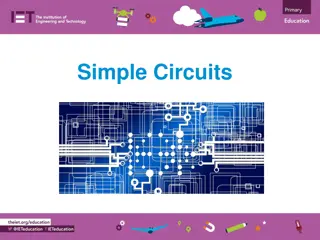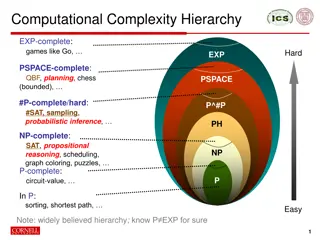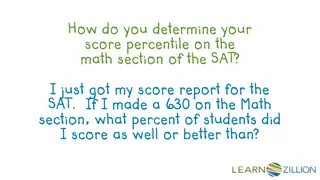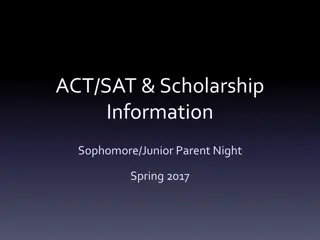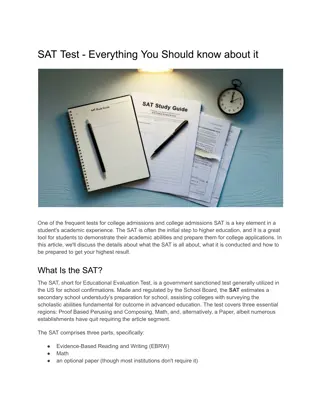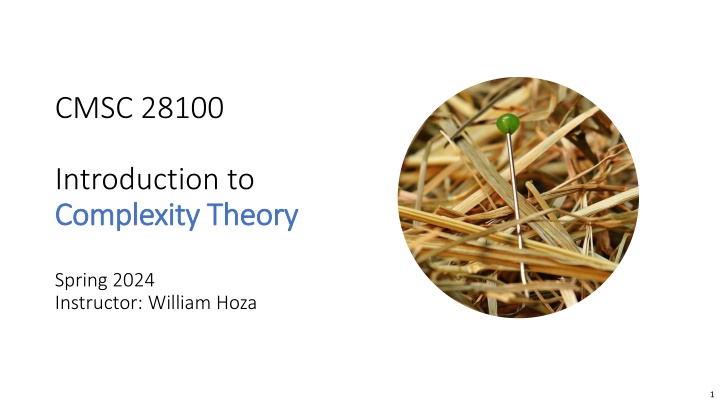
Circuit Satisfiability in Complexity Theory
Explore the concept of circuit satisfiability in Complexity Theory, diving into the NP-completeness and NP-hardness of CIRCUIT-SAT. Learn about the proof techniques and reductions involved in demonstrating these complexities.
Download Presentation

Please find below an Image/Link to download the presentation.
The content on the website is provided AS IS for your information and personal use only. It may not be sold, licensed, or shared on other websites without obtaining consent from the author. If you encounter any issues during the download, it is possible that the publisher has removed the file from their server.
You are allowed to download the files provided on this website for personal or commercial use, subject to the condition that they are used lawfully. All files are the property of their respective owners.
The content on the website is provided AS IS for your information and personal use only. It may not be sold, licensed, or shared on other websites without obtaining consent from the author.
E N D
Presentation Transcript
CMSC 28100 Introduction to Complexity Theory Complexity Theory Spring 2024 Instructor: William Hoza 1
Circuit satisfiability We say that a circuit ? is satisfiable if there exists ? {0,1}? such that ? ? = 1 Let CIRCUIT-SAT = { ? ? is a satisfiable circuit} Theorem: CIRCUIT-SAT is NP-complete. 2
Proof that CIRCUIT-SAT NP Given ? , where ? is an ?-input 1-output circuit: Pick ? 0,1? at random 1. Check whether ? ? = 1 (recall CIRCUIT-VALUE P) 2. Accept if ? ? = 1; reject if ? ? = 0 3. 3
Proof that CIRCUIT-SAT is NP-hard Let ? be any language in NP Our job: Design a mapping reduction from ? to CIRCUIT-SAT Idea: Let s build a verification circuit for ? 4
Given ?, how do we efficiently construct ?? Proof that CIRCUIT-SAT is NP-hard A: Simulate ? on ? and output the corresponding circuit B: Calculate ?, then make a ? ? grid of copies of ?0 (a fixed circuit) C: Inspect the transition function of ? and implement it as a circuit D:We don t; all that matters is the fact that ? exists Let ? be a nondeterministic TM that decides ? in time ? ? = poly ? Respond at PollEv.com/whoza or text whoza to 22333 Let ? = ?#? ? accepts ? when initialized with ? on tape 2 ? P PSIZE, and as discussed last time, the circuits are efficiently constructible Reduction step 1: Given ?, construct ? , where ? is a circuit that computes ?? for ? = ? + 1 + ? ? 5
Proof that CIRCUIT-SAT is NP-hard Reduction step 2 ? ? ?2 ?3 ?4 ?5 ?6 ?7 ?? 1 1 0 1 ?1 ?2 ?? ?1 0 ?# hard-coded into circuit ? ? if and only if there exists ? such that ? ?#? = 1 Reduction: ? ? = ? , where ? ? = ? ?#? 6
Proof that CIRCUIT-SAT is NP-hard Reduction: ? ? = ? , where ? ? = ? ?#? and ? computes ?? YES maps to YES: If ? ?, then Pr ? accepts ? 0 Therefore, there exists ? 0,1? ? such that ?#? ? Therefore, ? ?#? = 1 Therefore, ? ? = 1, so ? is satisfiable 7
Proof that CIRCUIT-SAT is NP-hard Reduction: ? ? = ? , where ? ? = ? ?#? and ? computes ?? NO maps to NO: Suppose ? is satisfiable, i.e., there exists ? 0,1? ? such that ? ? = 1 Then ? ?#? = 1, so ?#? ? Therefore, Pr ? accepts ? 0 Therefore, ? ? 8
Proof that CIRCUIT-SAT is NP-hard Reduction: ? ? = ? , where ? ? = ? ?#? and ? computes ?? Polynomial-time computable: 1. Compute ? . This takes poly ? = poly ? time 2. Plug in ?#. This takes poly ? time 9
NP-completeness NP-hard CIRCUIT-SAT NP-complete NP P 10
What else is NP-complete? We showed that CIRCUIT-SAT is NP-complete It turns out that a huge number of natural, interesting, and important languages are NP-complete! For example, we still want to show that CLIQUE is NP-complete To prove NP-hardness, we can chain reductions together 11
Chaining reductions together Claim: Suppose ?HARDis NP-hard and there is a polynomial-time mapping reduction ? from ?HARD to ?NEW. Then ?NEW is NP-hard Proof: Let ? be any language in NP There is a polynomial-time mapping reduction ? from ? to ?HARD Reduction from ? to ?NEW: ? = ? ? ? Poly-time computable YES maps to YES NO maps to NO 12
Chaining reductions together Consequence: To prove that CLIQUE is NP-complete, there is no need to reduce from an arbitrary language in NP We merely need to do a reduction from the one language CIRCUIT-SAT That s nice, but it s still not clear how to reduce CIRCUIT-SAT to CLIQUE Plan: We will reduce CIRCUIT-SAT to 3-SAT and 3-SAT to CLIQUE 13
?-CNF formulas Recall: A CNF formula is an AND of ORs of literals Definition: A ?-CNF formula is a CNF formula in which every clause has at most ? literals Example of a 3-CNF formula with two clauses: ? = ?1 ?2 ?6 ?5 ?1 ?2 14
The Cook-Levin Theorem Define ?-SAT = { ? ? is a satisfiable ?-CNF formula} The Cook-Levin Theorem: 3-SAT is NP-complete Proof: We need to show two things. 1. We need to show 3-SAT NP. What is the certificate? 2. We need to show that 3-SAT is NP-hard. Reduction from CIRCUIT-SAT 15
Gate gadgets Define the following Boolean functions: CHECK-NOT ?,? = 1 if ? = ? 0 otherwise CHECK-AND ?,?,? = 1 if ? = ? ? 0 otherwise CHECK-OR ?,?,? = 1 if ? = ? ? 0 otherwise Each can be represented by a 3-CNF formula. (Every function has a CNF representation!) 16
Reduction from CIRCUIT-SAT to 3-SAT Reduction: ? ? = ? , where ? is a 3-CNF defined as follows Circuit ? has variables ?1,?2, ,?? and AND/OR/NOT gates ?1, ,?? Assume without loss of generality that ?? is the output gate Formula ? has ? + ? variables, which we denote ?1, ,??,?1, ,?? Note: In ?, ?? is the name of a gate. In ?, ?? is the name of a variable 17
Reduction from CIRCUIT-SAT to 3-SAT For each AND/OR/NOT gate ?? in the circuit ?, define a 3-CNF ??: ?? ?? ?? ? ? ? ? ? ??= CHECK-OR ??,?,? ??= CHECK-NOT ??,? ??= CHECK-AND ??,?,? Reduction produces ?:= ?1 ?2 ?? ?? 18
Reduction example ?5 ?1= CHECK-NOT ?1,?1 = ?1 ?1 ( ?1 ?1) ?4 ?3 ?2= CHECK-NOT ?2,?2 = ?2 ?2 ?2 ?2 ?3= CHECK-AND ?3,?1,?2 = ?1 ?2 ?3 ?1 ?3 ?2 ?3 ?1 ?2 ?4= CHECK-AND ?4,?1,?2 = ?4 ?1 ?4 ?2 ?4 ?1 ?2 ?2 ?1 ?5= CHECK-OR ?5,?3,?4 = ?5 ?3 ?5 ?4 ?5 ?3 ?4 ? = ?1 ?1 ?3 ?1 ?2 ?5 ?4 ?1 ?1 ?2 ?2 ?4 ?1 ?5 ?3 ?4 ?5 ?2 ?2 ?4 ?2 ?4 ?1 ?2 ?5 ?3 ?3 ?1 ?3 ?2 19
YES maps to YES Claim: If the circuit ? is satisfiable, then the 3-CNF formula ? is also satisfiable Proof: We are assuming there is some ? {0,1}? such that ? ? = 1 For each ?, assign to ?? (the variable) the value that ?? (the gate) outputs when we evaluate ? on ? 20


